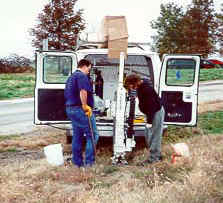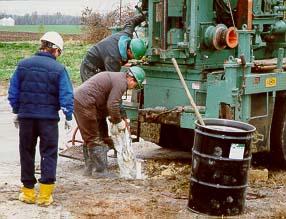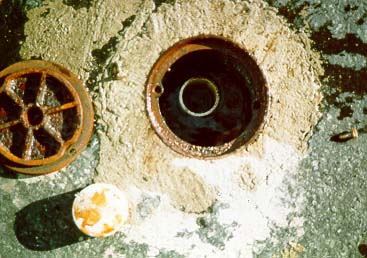Frequently Asked Questions about Leaking USTs
- 1. Q. Where do the Leaking Underground Storage Tank (UST) Program requirements originate?
- 2. Q. What is the definition of an UST?
- 3. Q. I reported a release from my farm UST to the Illinois Emergency Management Agency (IEMA). Is my UST regulated by the Illinois EPA’s Leaking UST Program?
- 4. Q. Is my residential heating oil tank regulated by the Illinois EPA’s Leaking UST Program?
- 5. Q. My heating oil UST is used to store heating oil for resale. Is it regulated by the Illinois EPA’s Leaking UST Program?
- 6. Q. If there is a release from my 100-gallon UST, am I required to follow the Leaking UST Program regulations?
- 7. Q. I have an aboveground storage tank (AST) on my property. Is it regulated by the Illinois EPA’s Leaking UST Program?
- 8. Q. My UST was taken out of operation sometime before 1974. Is it regulated by the Illinois EPA’s Leaking UST Program?
- 9. Q. What are early action activities?
- 10. Q. What should I do if I need to remove free product beyond 45 days of discovery of free product?
- 11. Q. What is site classification?
- 12. Q. What is site investigation?
- 13. Q. What is the liability associated with my UST release, regardless of the applicable Leaking UST Programs regulation?
- 14. Q. If my UST release is not regulated by the Leaking UST Program, can I still get help from the Illinois EPA?
- 15. Q. Do I have to use the services of an Illinois EPA-approved consultant?
- 16. Q. Do I have to use the Illinois EPA Budget and Billing Forms?
- 17. Q. What early action activities are payable from the UST Fund?
- 18. Q. Why is my application for payment being returned?
- 19. Q. Are costs for obtaining institutional controls or engineered barriers payable from the UST Fund?
- 20. Q. If I do not own the UST, can I access the UST Fund?
- 21. Q. Who reviews applications for payment from the UST Fund?
- 22. Q. How do I find out the status of my application for payment?
- 23. Where to Direct Your UST and Leaking UST Questions
A. Illinois’ environmental laws and regulations governing leaking USTs are found in:

Sample collection using
direct push technology
- Environmental Protection Act (Act), Title XVI, Petroleum Underground Storage Tanks; and
- Title 35, Illinois Administrative Code (35 Ill. Adm. Code), Subtitle G, Part 731, Underground Storage Tanks; Part 732, Petroleum Underground Storage Tanks; and Part 734, Petroleum Underground Storage Tanks.
A. An UST includes the tank, all piping and any part of an UST system that contains a regulated substance. By definition, any system having ten percent or more of the total tank volume below ground is considered to be an UST.
A. Yes, if your farm UST has a capacity of more than 1,100 gallons and contains petroleum (other than heating oil) or a hazardous substance. (See the question and answer below for information regarding heating oil tanks.) A farm UST must be located on land devoted to producing crops or raising livestock or fish; this land can include associated residences and structures.
A farm or residential tank of 1,100 gallons or less capacity used for storing motor fuel for noncommercial purposes is exempt from the requirements of 35 Ill. Adm. Code 731, 732, and 734.

Soil core sampling
A. No, residential and farm heating oil tanks (that is, tanks used to store heating oil for consumptive use on the premises where stored and which serve a farm or residential unit) are not, by definition, USTs and, therefore, are not subject to the Leaking UST Program regulations.
A. The owner or operator of a heating oil UST used to store heating oil for resale or for use in a manufacturing process has the option to elect to proceed in accordance with Leaking UST Program regulations—so long as an order for removal and, if necessary, site investigation and corrective action has not been issued by the OSFM. Submittal of a Heating Oil Underground Storage Tank Election form is required.
A. No, any UST system whose capacity is 110 gallons or less is excluded from the Leaking UST Program requirements.
A. No, ASTs are exempt from the Leaking UST Program requirements. The Office of the State Fire Marshal’s (OSFM) Division of Fire Prevention regulates the operation and maintenance of ASTs.
A. Yes, the petroleum UST regulations apply to the release. However, the tank owner or operator may submit Election to Proceed under 35 Ill. Adm. Code 734 and Pre-1974 UST Notification forms to notify the Illinois EPA that the release was from a pre-1974 tankand that an order for removal has not been issued by the OSFM. The owner or operator can then decide whether to perform corrective action under the Leaking UST Program regulations. Releases from USTs taken out of operation before January 2, 1974, are not subject to mandatory corrective action under the Leaking UST Program unless the OSFM issues an order for removal and, if necessary, site investigation and corrective action. Please note that the costs to remediate contamination from a release from a pre-1974 tank are not eligible for payment from the UST Fund.
A. After the release is reported to the IEMA, the tank owner or operator may conduct certain activities before submitting any plans or budgets to the Illinois EPA’s Leaking UST Section. These early action activities include:
- Preparation of the 20-Day Certification and 45-Day Report;
- Vapor abatement;
- Free product removal and preparation of the Free Product Removal Report;
- Unplanned UST removal or abandonment if the activity is in response to a tank release;
- The removal of up to four feet of visibly contaminated fill material and any groundwater in the excavation that exhibits a sheen;
- The disposal or ex-situ treatment of up to four feet of visibly contaminated fill material; and
- The collection and analysis of samples from the excavation limits (after removal of visibly contaminated fill material or after removal of the UST) or from areas surrounding the UST systems (if the system remains in place) to measure for the presence of a release.
For purposes of payment from the UST Fund, these activities must be completed within 45 days after initial notification to IEMA of a release plus 14 days. To obtain an extension, you must submit a request to the Illinois EPA in writing within the 45 days plus 14 days time frame.
A. Owners and operators may remove free product for up to 45 days after discovery without the requirement for an approved plan or budget. These activities are paid as an early action activity. If, within 45 days of discovery, free product is not reduced to one-eighth of an inch or less, the owner or operator must submit a free product removal plan and budget for additional recovery activities. Costs will be paid under the approved free product removal budget. Free product removal reports must be submitted quarterly.
A. Site classification determines what, if any, additional corrective action is needed in response to the UST release after early action is completed. Site classification is required only of incidents subject to 35 Ill. Adm. Code 732. Three methods for classification exist.
Methods One and Two classify the site into one of the following categories:
- No Further Action (in which no additional remediation is required after site classification is completed);
- Low Priority (in which three years of groundwater monitoring are required after site classification is completed); or
- High Priority (which requires additional corrective action, such as soil remediation, after site classification is completed).
Methods One and Two take into account the following site characteristics: geology, presence of groundwater contamination, potable wells in the area, Class III groundwater in the area, whether any surface bodies of water have been impacted by the release, and migration pathways. Methods One and Two generally require the advancement of one or more soil borings and may require the installation of monitoring wells for a groundwater investigation.
A third method, Classification by Exposure Pathway Exclusion, is based on 35 Ill. Adm. Code 742—Tiered Approach to Corrective Action Objectives (TACO). This method involves evaluation of the following TACO exposure routes (pathways): inhalation, soil ingestion, and groundwater ingestion. Initially, the contaminant levels at the site are compared with TACO Tier 1 remediation objectives for each specific exposure route. If any of the contaminant levels exceeds the TACO Tier 1 remediation objectives, it is necessary to determine if the specific route can be excluded from consideration. Defining the extent of soil and groundwater contamination is part of Classification by Exposure Pathway Exclusion.
Classification by Exposure Pathway Exclusion classifies sites as either:
- No Further Action (no additional remediation is required after site classification is completed), or
- High Priority (where additional corrective action in accordance with TACO would be required, such as soil removal or the placement of an engineered barrier, after site classification is completed).
This third method of classification was available to tank owners or operators who made the election prior to March 1, 2006. Owners or operators who wish to classify by this method must elect to proceed in accordance with 35 Ill. Adm. Code 734 and perform site investigation and corrective action in accordance with Part 734.

Installing a monitoring well
A. A site investigation, required only of incidents subject to 35 Ill. Adm. Code 734, is designed to determine the nature, concentration, direction of movement, rate of movement, and extent of contamination exceeding the most stringent TACO Tier 1 remediation objectives in the soil and groundwater. Generally, this requires the drilling of soil borings to collect soil samples and the installation of monitoring wells to collect groundwater samples from the subsurface.
Site investigation proceeds in three stages—Stages 1 and 2 to define the extent of contamination on-site and Stage 3 to define the extent of contamination off-site. If, after completion of any stage, the extent of contamination has been defined, the UST owner or operator must submit to the Illinois EPA for approval a site investigation completion report.
An UST owner or operator intending to seek payment from the UST Fund for site investigation activities must submit to the Illinois EPA for approval a site investigation budget with the corresponding plan. In order to receive payment from the Fund, actual costs of the previous stage of site investigation activities must be submitted with the subsequent plan or report.
A. Any UST release is cause for concern. The environmental contamination caused by the leaking tank may subject you to other provisions of the Act. Furthermore, you may be liable for third-party lawsuits should a release from your tank harm human health or the environment. For more information about liability issues, see the fact sheet entitled “ Responsibility and Liability Issues.”
A. Yes. For a fee, you may voluntarily participate in the Site Remediation Program (SRP). Successful participation in this program will assure compliance with all applicable regulations and provide you with a No Further Remediation Letter upon completion of evaluation or cleanup activities. For more information, call 217-524-3300 or see the SRP’s Web page.
A. No. The Illinois EPA does not maintain a list of approved consultants. It should be noted that, in the Leaking UST Program, a Licensed Professional Engineer or a Licensed Professional Geologist registered in the State of Illinois must certify all reports, budgets, and applications for payment. However, only a Licensed Professional Engineer may certify the Corrective Action Completion Report.
When choosing a consultant, evaluate the consulting firm's qualifications, including but not limited to:
- Experience and capability;
- Willingness to explain leaking UST site cleanup options so owners and operators can make informed decisions;
- Project timetable; and
- Price.
The owner or operator of the UST should stay involved throughout the process, keep accurate records, save vouchers and invoices, and monitor all costs.
A. Yes. Illinois EPA budget and billing forms must be used. For assistance in completing the forms, follow the general and supplemental instructions.
A. The Illinois EPA reviews applications for payment from the UST Fund on a site-specific basis. However, the following activities are generally payable from the UST Fund if the costs are incurred within 45 days after initial notification to IEMA of a release plus 14 days and if the costs are reasonable and justified.
- Costs associated with preparation of the 20-Day Certification and 45-Day Report;
- Costs associated with vapor abatement;
- Costs associated with free product removal and preparation of the Free Product Removal Report;
- Costs for unplanned UST removal or abandonment if the activity is in response to a release;
- Costs associated with the removal of up to four feet of visibly contaminated fill material and any groundwater in the excavation that exhibits a sheen;
- Costs associated with the disposal or ex-situ treatment of up to four feet of visibly contaminated fill material; and
- Costs associated with collection and analysis of samples from the excavation limits (after removal of visibly contaminated fill material or after removal of the UST) or from areas surrounding the UST systems (if the system remains in place). Sample analysis is limited to the indicator contaminants outlined in 35 Ill. Adm. Code 732.310 or 734.405.
Budgets are not required for early action activities. For purposes of payment from the UST Fund, these activities must be completed within 45 days after initial notification to IEMA of a release plus 14 days. To request an extension, you must submit it to the Illinois EPA in writing within the 45 days plus 14 days time frame.

A groundwater monitoring well
A. Your application for payment may be incomplete. The following elements are needed for a payment request from a site subject to 35 Ill. Adm. Code 732 or 734:
- Invoices and documentation in support of the claim;
- A certification from a Licensed Professional Engineer or a Licensed Professional Geologist acknowledged by the owner or operator that the work performed has been in accordance with a technical plan approved by the Illinois EPA;
- A statement of the amount approved in the corresponding budget and the amount actually requested for payment along with a certified statement by the owner or operator that the amount requested has been used according to the budget plan approved by the Illinois EPA;
- A copy of the Illinois OSFM or Illinois EPA eligibility and deductible determination;
- Proof that approval of the payment requested will not exceed the limitations set forth in 35 Ill. Adm. Code 732.604(a) and (b)(1) for sites subject to Part 732 or 734.620(a) and (b)(1) for sites subject to Part 734;
- A Federal Taxpayer Identification Number and Legal Status Disclosure Certification;
- A Private Insurance Coverage Questionnaire and Affidavit; and
- A Women and Minority Business Enterprises form.
If your request for payment is returned, the Illinois EPA will send you a letter that details what information is missing.
A. Costs associated with obtaining an institutional control are payable from the UST Fund provided the institutional control is part of the approved corrective action plan and budget for the tank release and the costs are reasonable and justified. An institutional control is a legal mechanism for imposing a restriction on land use, such as a restriction to industrial/commercial land use.
Costs for an engineered barrier are generally payable from the UST Fund provided the engineered barrier is part of the approved corrective action plan and budget for the tank release and the costs are reasonable and justified. An engineered barrier limits exposure to or controls the migration of contaminants of concern. For instance, a barrier of asphalt paving can prevent the ingestion of contaminated soil.
A. Only the owner or operator of an UST can access the UST Fund. The OSFM registers an UST to its owner or operator, and UST registration is a requirement of UST Fund eligibility.
If the UST is still in the ground on a property you already own or intend to purchase, contact the OSFM to determine if you meet the eligibility requirements for the UST Fund. Be prepared to tell the OSFM if the UST is still in operation or provide the date the UST was taken out of service.
If an UST with a reported release was removed from the property, a future property owner may become the tank owner and access the UST Fund for cleanup of contamination caused by the removed UST—provided the OSFM eligibility criteria are met. Before submitting the Election to Proceed as “Owner” form, you should contact the OSFM to gather information about UST registration, eligibility to access the UST Fund, and the deductible amount.
A. The Illinois EPA's Leaking UST Claims Unit reviews claims to determine eligible costs in accordance with environmental laws and regulations. Leaking UST Section project managers review the budgets for site classification, site investigation, and corrective action plans.
A. Please contact the Illinois EPA's Leaking UST Claims Unit at 1-217-524-3300 to learn the status of your payment claim.
If you have questions concerning permits required for tank installations, upgrades or removals; leak prevention or detection requirements; financial responsibility requirements; or eligibility and deductible determinations for the UST Fund, contact:
Office of the State Fire Marshal
Division of Petroleum and Chemical Safety
1035 Stevenson Drive
Springfield, Illinois 62703
217-785-1020
www.state.il.us/osfm/PetroChemSaf/home.htm
If you have questions concerning the review of budget plans and technical reports, or the status of applications for payment from the UST Fund, contact:
Illinois Environmental Protection Agency
Leaking Underground Storage Tank Section
2520 West Iles Avenue
P.O. Box 19276
Springfield, Illinois 62794-9276
217-524-3300
This publication is for general information only and is not intended to replace, interpret, or modify laws, rules, or regulations.

